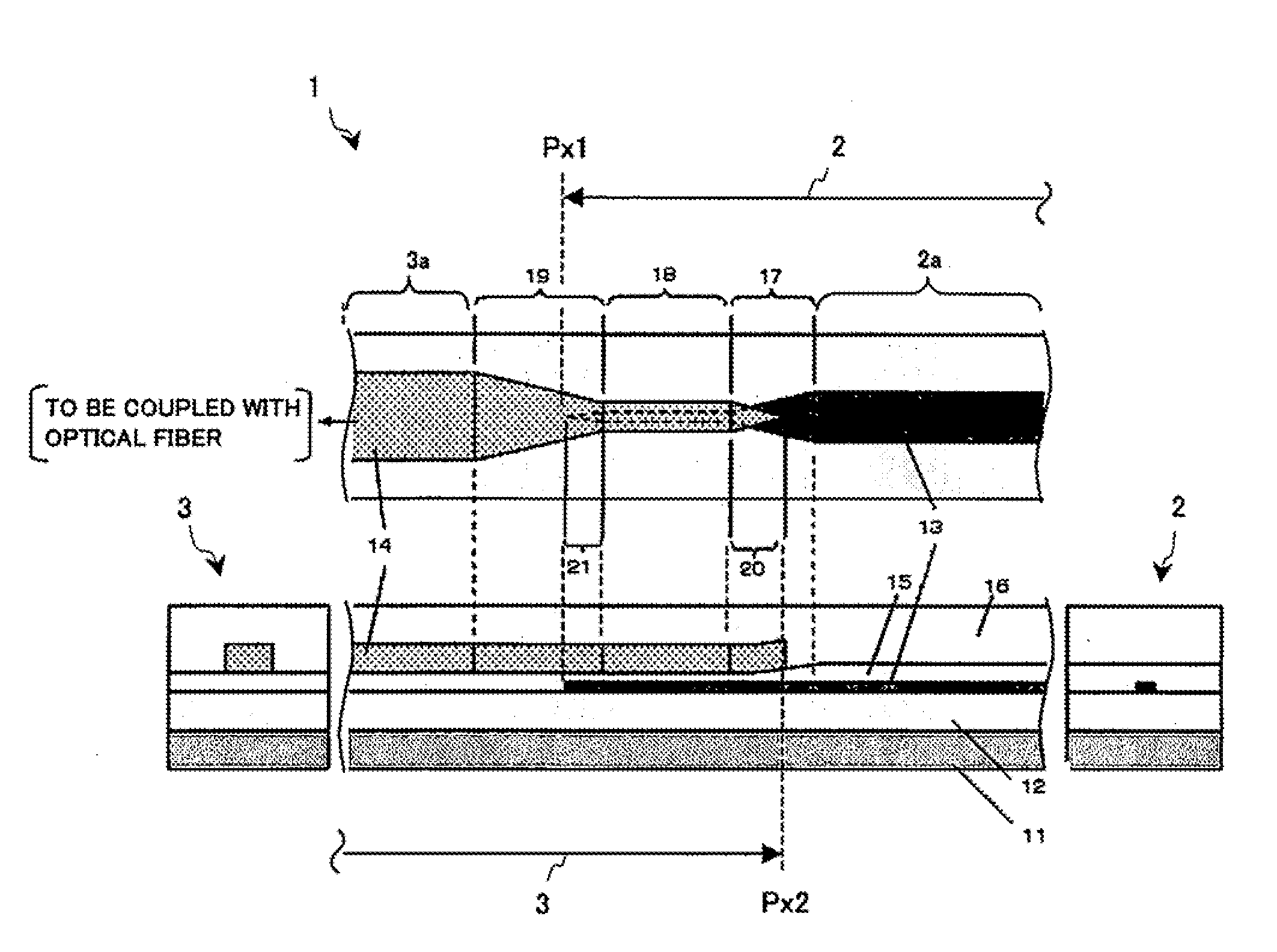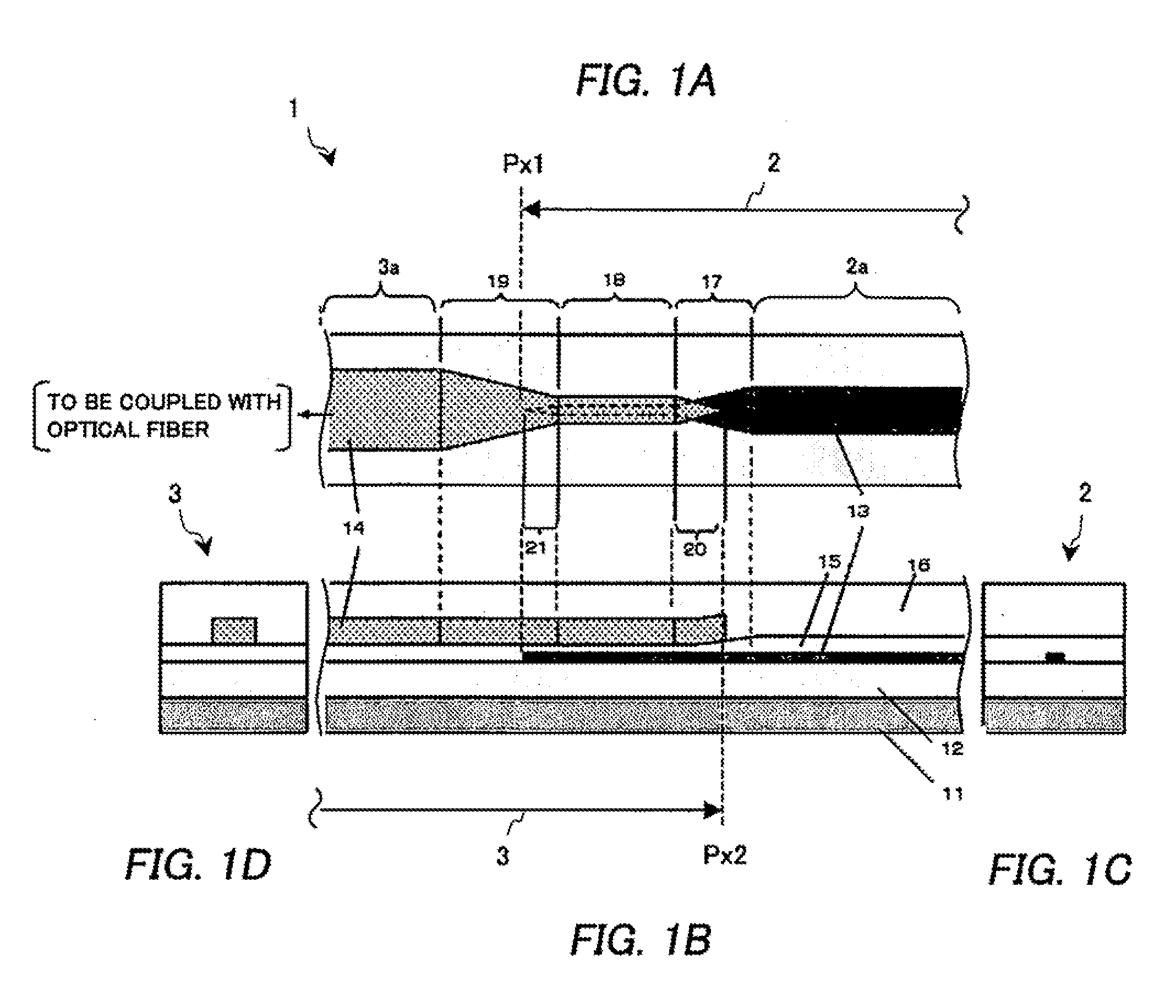Optical waveguide and spot size converter using the same
a technology of optical waveguides and spot size converters, applied in the direction of optical waveguide light guides, instruments, optics, etc., can solve the problems of difficult to change difficult to adjust the mode diameter to the mode diameter of optical fibers, and high cost, and achieve high efficiency.
- Summary
- Abstract
- Description
- Claims
- Application Information
AI Technical Summary
Benefits of technology
Problems solved by technology
Method used
Image
Examples
example 1
[0052]FIG. 1 is a schematic diagram which schematically illustrates an example of the configuration of a spot size converter that uses an optical waveguide 1 according to a first example of the present invention. FIG. 1A is a cross-sectional view of upper-surface essential components. FIG. 1B is a cross-sectional view of plain-surface essential components. FIG. 1C is a cross-sectional view of right-side-surface essential components. FIG. 1D is a cross-sectional view of left-side-surface essential components. Incidentally, FIGS. 1A and 1B show the cross-section surface of an essential portion of the optical waveguide 1. As indicated by undulating lines in the diagram, both ends of the optical waveguide 1 are not limited to the end faces of an actual waveguide chip. Moreover, in the case of the example illustrated by the diagram, the optical waveguide 1 is coupled with the optical fiber. Alternatively, the optical waveguide 1 may be applied in other cases, such as when the optical wav...
example 2
[0068]The following describes a second example of the present invention in detail with reference to the accompanying drawing.
[0069]FIG. 2 is a schematic diagram which schematically illustrates an example of the configuration of an optical waveguide 1 according to the present example. FIG. 2A is a cross-sectional view of upper-surface essential components. FIG. 2B is a cross-sectional view of plain-surface essential components. FIG. 2C is a cross-sectional view of right-side-surface essential components. FIG. 2D is a cross-sectional view of left-side-surface essential components.
[0070]The optical waveguide 1 of the present example shown in FIGS. 2A to 2D has the same basic configuration as the optical waveguide of the first example has. However, the difference between the present example and the first example is that the optical waveguide 1 of the present example does not have the first reflection-free termination section 20 and the second reflection-free termination section 21. The ...
example 3
[0074]The following describes a third example of the present invention in detail with reference to the accompanying drawing.
[0075]FIG. 3 is a schematic diagram which schematically illustrates an example of the configuration of an optical waveguide according to the present example. FIG. 3A is a cross-sectional view of upper-surface essential components. FIG. 3B is a cross-sectional view of plain-surface essential components. FIG. 3C is a cross-sectional view of right-side-surface essential components. FIG. 3D is a cross-sectional view of left-side-surface essential components.
[0076]The optical waveguide 1 of the present example shown in FIGS. 3A to 3D has the same basic configuration as the optical waveguide of the first example has. However, the difference between the present example and the first example is that in the optical waveguide 1 of the present example, the mode conversion section 19 does not have a tapered portion. The following describes the difference.
[0077]The present ...
PUM
 Login to View More
Login to View More Abstract
Description
Claims
Application Information
 Login to View More
Login to View More - R&D
- Intellectual Property
- Life Sciences
- Materials
- Tech Scout
- Unparalleled Data Quality
- Higher Quality Content
- 60% Fewer Hallucinations
Browse by: Latest US Patents, China's latest patents, Technical Efficacy Thesaurus, Application Domain, Technology Topic, Popular Technical Reports.
© 2025 PatSnap. All rights reserved.Legal|Privacy policy|Modern Slavery Act Transparency Statement|Sitemap|About US| Contact US: help@patsnap.com



